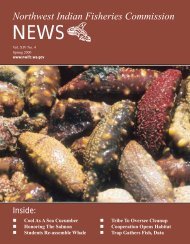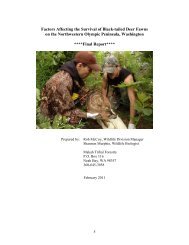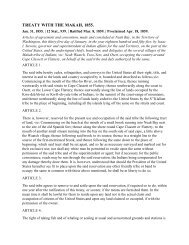NWIFC News - NWIFC Access - Northwest Indian Fisheries ...
NWIFC News - NWIFC Access - Northwest Indian Fisheries ...
NWIFC News - NWIFC Access - Northwest Indian Fisheries ...
Create successful ePaper yourself
Turn your PDF publications into a flip-book with our unique Google optimized e-Paper software.
Chum Test Fishery<br />
Marks 25 Years<br />
Of Data Collection<br />
It’s rare that 25 years of data about a<br />
specific salmon run is readily available,<br />
but western Washington treaty tribes<br />
have such information at their fingertips,<br />
thanks to a test fishery that helps them<br />
manage fall chum salmon harvests.<br />
The <strong>Northwest</strong> <strong>Indian</strong> <strong>Fisheries</strong><br />
Commission (<strong>NWIFC</strong>) and South Puget<br />
Sound treaty <strong>Indian</strong> tribes conduct the test<br />
fishery at Apple Cove Point near Kingston<br />
each fall.<br />
“The test fishery’s strength is that it has<br />
been taking place every year since 1981,”<br />
said Bill Patton, South Sound biologist<br />
for <strong>NWIFC</strong>. “We primarily look for<br />
differences in run sizes.”<br />
The tribal and state biologists compare<br />
test catches from previous years to provide<br />
an overall look at the health of the chum<br />
run and predict the annual run size.<br />
The long-term data helps biologists see<br />
how Puget Sound fall chum are faring.<br />
In the last decade, the number of chum<br />
returning has generally increased, Patton<br />
said. In the 1990s, only about 200,000-<br />
300,000 fish were returning each fall.<br />
In 2005, the run came in at 407,000 and<br />
in 2006, the run was estimated at more<br />
than 700,000.<br />
Tribal and state biologists also take<br />
scale samples to determine the salmon<br />
run’s age distribution of 3-, 4- and 5-<br />
year-old fish. Because most chum don’t<br />
mature until age 4, if the test fishery<br />
catches a large number of 3-year-olds,<br />
it’s usually a good indicator that there<br />
will be a large return of 4-year-olds the<br />
following year, Patton said.<br />
Biologists also record how many<br />
male and female chum are caught. It is<br />
generally thought that males return earlier<br />
than females during the run. When there<br />
are equal numbers of both sexes caught<br />
during the fishery, it suggests that the run<br />
is at its peak.<br />
12<br />
In the end, the tribes get<br />
an idea of how much they<br />
can harvest. Biologists<br />
estimate the total number<br />
of chum returning to<br />
the South Sound, then<br />
subtract the escapement<br />
number – the number of<br />
fish that need to make<br />
it to the region’s rivers<br />
and streams to spawn<br />
– and the result is the<br />
harvestable amount.<br />
The treaty tribes harvest<br />
half of the surplus<br />
amount. In 2006, the<br />
treaty share was about<br />
330,000 chum.<br />
Bill Patton, <strong>NWIFC</strong> biologist, takes a scale sample<br />
from a chum, while <strong>NWIFC</strong> biometrican Rick Coshow<br />
records the sex and length of the fish.<br />
A test fishery fisherman loads the chum catch on board.<br />
Photos: T. Royal<br />
While there haven’t been<br />
any major differences found<br />
from year to year, other than<br />
variable numbers of chum<br />
coming back to Puget Sound,<br />
the test fishery data plays an<br />
important role in helping the<br />
tribes manage their chum<br />
harvests.<br />
“We have these two really<br />
good in-season tools – the<br />
test fishery and non-treaty<br />
commercial catch data –<br />
that help biologists gather<br />
the best possible in-season<br />
information for chum harvest<br />
management in the South<br />
Sound,” Patton said. “While<br />
relying on commercial<br />
fishery data alone would<br />
probably suffice, having 25<br />
years of consistent data from<br />
a test fishery is extremely<br />
beneficial.” – T. Royal









